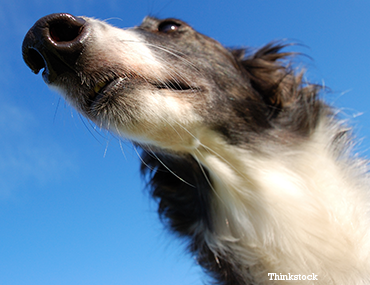
Nose bleeds - often medically called “epistaxis” - are never normal in dogs or cats. When they occur, they can quickly turn into severe bleeding and be accompanied by secondary signs of shock.
There are several causes of epistaxis
- Trauma
- Clotting abnormalities (e.g., von Willebrand’s disease, hemophilia, or disseminated intravascular coagulation)
- Platelet problems
- Cancer (e.g., nasal adenocarcinoma)
- Benign tumors (e.g., polyps)
- Foreign bodies (e.g., sticks, plant material, etc.)
- Infections (e.g., parasites, fungal, tick-born, or bacterial causes)
- Dental disease (e.g., tooth root abscesses)
- Vasculitis
It’s important to determine if the nose bleed is from one nostril (i.e., unilateral) or from both nostrils (i.e., bilateral), as that may help determine where the problem is. Unilateral nose bleeding is often due to disease on one side of the nose like cancer, tumors, or foreign bodies. Bilateral bleeding is often due to systemic (i.e., whole body) problems like a platelet or clotting abnormality.
No particular breed is recognized as being predisposed to nose bleeds, although certain medical problems that can cause epistaxis are more commonly seen in purebred dogs. Cocker spaniels and Rottweilers are more often predisposed to immune-mediated thrombocytopenia (ITP), which causes their immune system to destroy their own platelets. Dolichocephalic breeds (e.g., breeds with long noses like Irish wolfhounds, German shepherds, rough Collies, etc.) may potentially be at increased risk for nasal tumors. Certain breeds of dogs (e.g., Dobermans) are more predisposed to inherit clotting abnormalities (e.g., vonWillebrand’s deficiency) and can develop severe bleeding from surgery or even minor wounds.  Clinical signs accompanying epistaxis
Clinical signs accompanying epistaxis
Signs may be acute or chronic; depending on the underlying disease, signs may include the following:
- Abnormally colored discharge from the nose (may start as clear and progress to pus-colored)
- Snorting frequently
- Pawing at the nose or excessive rubbing
- Halitosis
- Not eating (inappetance)
- Anorexia
- Weight loss
- Abnormal odor from the mouth or nose
- Abnormal swelling over the nose, gums, or mouth
- Black tarry stool (due to swallowing of the blood and its passing along the intestinal tract)
If your dog or cat has epistaxis
Certain diagnostic tests are important to rule out underlying clotting problems:
- A complete blood count to look at the white and red blood cell count, along with the platelet count.
- A chemistry panel to look at the kidney and liver function, along with the electrolytes and protein level.
- A coagulation panel which often includes a platelet count, prothrombin time (PT), and activated partial thromboplastin time (aPTT).
- A buccal mucosal bleeding time (BMBT) to measure the actual time to active clotting from a small incision made on the inside lip of a dog (typically done under anesthesia).
- Advanced testing to rule out tick-borne infections (e.g., ehrlichia, Rocky Mountain Spotted Fever, etc.) that can cause a low platelet count
- Advanced tests to rule out fungal infections or other infectious causes
- X-rays of the nose, possibly mouth (i.e., dental radiographs), chest, and abdomen to rule out underlying cancer or metabolic problems.
- A CT or MRI to look at minute “x-ray slices” of the nostrils
- A rhinoscopy, where a small camera and biopsy tool enters the nostrils to evaluate the nasal cavity and biopsy any abnormalities.
Treatment to stop the bleeding may include ice or cold compresses to the area, dilute epinephrine applied topically to the nostril, or in severe cases, general anesthesia and gauze packed into the nasal cavity to directly control the bleeding. Depending on the underlying cause treatment may include blood transfusions, plasma transfusions (for vonWillebrand’s disease), immunosuppressive therapy, antibiotics, antifungals, or even surgery.
With nose bleeds or any disease or medical problem, remember, the sooner it is diagnosed, the sooner it can be treated. If you notice epistaxis in your dog or cat, seek immediate veterinary attention!
If you have any questions or concerns, you should always visit or call your veterinarian -- they are your best resource to ensure the health and well-being of your pets.
